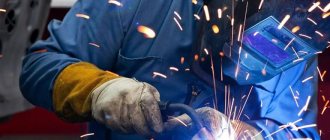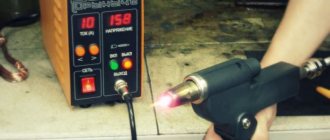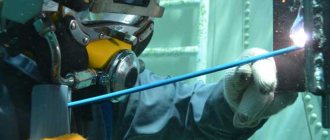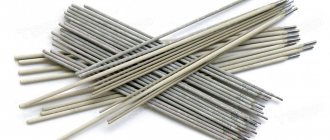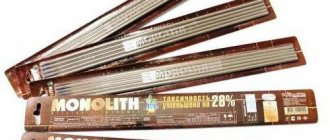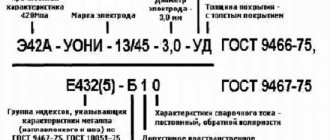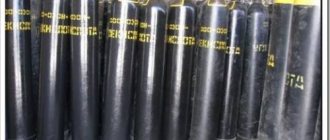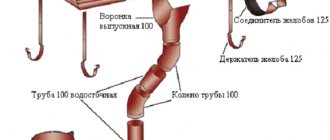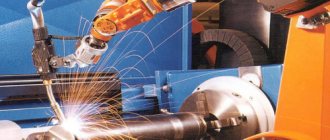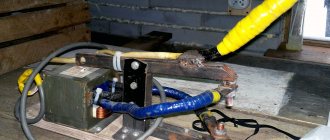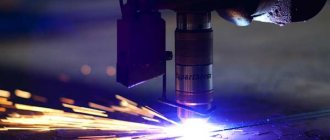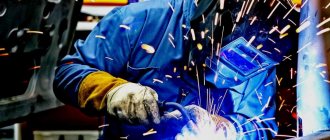Standards for welding work
The purpose of the standard values is to regulate the quality of the work performed, the speed of completion, the time it takes to complete certain works, production standards, the energy consumption that will be required to perform the welding work, the required number of components, and the time required to perform the welding.
In addition, the control of welded joints and methods for its implementation are regulated. The requirements of the SNiP document are subject to the release of drawings and documentation, in particular, technical specifications. Particular attention is paid to ensuring safety when carrying out welding work.
SNiP consists of four parts independent from each other, which contain standards for welding work.
Rules regarding time
The standard time for welding is calculated based on the concept of the standard time for welding 1 m of a seam. A qualified welder must have the ability to independently calculate the time during which he can perform specific operational actions. The performance and productivity of the work performed will depend on the correct calculation.
When making calculations, the welder must take into account the time standards for welding work specified in SNiP. They consist of the time spent specifically on the welding process, as well as the time spent on preparatory work and various production operations.
There are three types of production operations included in the concept of norm:
- Main.
- Auxiliary.
- Additional.
The concept of the main production operation includes the provision of consumables for welding, the necessary processing of the main metals being welded and carrying out preparatory operations. Basic production welding is the welding process performed.
The auxiliary operation includes: delivery to the welding site of the parts to be welded and the selected equipment, further control of the resulting joint and its movement according to the technological process, for example, to the assembly workshop.
Additional time is taken into account for servicing the process, setting the necessary parameters on the equipment, drying the electrodes, checking the functionality of the devices used, replacing the electrodes, and applying flux. This concept may include the time it will take to deposit, if necessary.
The calculation must include time for caring for your workplace, changing into a protective suit, rest and lunch break.
When calculating, the qualifications of the performer are taken into account, which affects the speed of the welding process, and a special coefficient is applied. There are several methods for calculation, the most common of which is calculation using work units. Each unit is equated to one product being welded.
Production rate
The standardization of welding work regarding their production determines the work performed in a specified time. The unit of measurement is the number of products or the value of the weld seam in meters that have undergone the welding process in one hour or per shift. The production rate can be a component of the time rate or calculated separately.
Electricity consumption rate
SNIP for welding requires keeping records of the costs of electricity required to carry out the work. They depend on the equipment used and its power, indicated in the passport. In addition, sufficient lighting of the work area is necessary. The unit of measurement is kilowatt-hours.
Standard for components
When welding, not only time and electricity are consumed, but also components and tools. SNiP for welding work also provides for these circumstances. Components without which welding cannot be carried out include electrodes, flux, and gas.
Costs of this type include wear and tear on equipment and individual specific elements - roller guides, contact jaws and similar products. Equipment wear and tear depends on numerous factors. For example, on the material used to manufacture components, as well as on the operating mode selected and installed on the equipment.
Timing
For the convenience of carrying out calculations, SNiP for welding contains auxiliary material for faster and more convenient calculations. These include various tables. An example is the following table for standardization of welding work:
The table given as an example applies to conditions where welding is carried out on only one side and there is no bevel of the edges. In this case, the position of the seam in space and the category assigned to this type of work play a role. The thickness of the parts to be welded is of great importance, which takes into account the time standards for welding metal structures.
Welding time can be calculated using the following formula:
Where:
- t0 is the required time;
- L —seam length;
- F is the cross-sectional area of the seam;
- I is the current value;
- Kn is a coefficient characterizing surfacing.
In the indicated formula, the value 7.85 is the density of the metal. In each specific case, you should substitute your own value. To calculate the time spent on welding work in one work shift, the result of the calculation should be multiplied by the number of hours using the formula.
If gas welding is carried out, it is convenient to use the following formula:
Where:
- S —thickness of the metal to be welded;
- K is a coefficient depending on the metal. It will be different for different species.
The formula used to calculate welding time with oxygen is:
Where:
- L is the length of the welds;
- V is the welding speed.
Unified time standards for welding work are specified in the normative document SNiP. The unit of measurement can be the welding time of 1 meter of seam. Also in the calculations, a unit of measurement is used, such as the welding rate in meters per day.
Organization of the workplace for successful compliance with standards
In order for all design standards for welding work to be met, it is necessary to properly organize the place where the welder will work.
It is arranged in accordance with the recommendations of the scientific labor organization NOT. Sitting at a metal workbench should be comfortable. There should be a protective visor on top. The room must be equipped with exhaust ventilation. There must be sockets for connecting welding equipment. Safety equipment is required.
Welding standards - rules of definition and units of measurement
The article describes the features of aluminum welding. Mention is made of certain difficulties encountered during this complex process. It also talks about the components necessary for welding. The aluminum welding process itself is also described in detail.
In our article we will look at what a welding arc is, and also talk about its key features and qualities. In addition, we will get acquainted with the types of arcs for welding, and separately consider what conditions need to be created for a welding arc to occur.
Semi-automatic welding machines are becoming very popular today. The article introduces the basic principles of their operation and the possibility of using them for welding pipes. The article also pays attention to the preliminary preparation of the pipe surface before welding.
stalevarim.ru
Safety rules according to SNIP
Labor safety of welding work in construction in SNiP is specified in Part 1, which contains general requirements. The list containing the scope of application also indicates the manufacture of structures and products. The document states that before welding can begin, the work manager is obliged to check compliance with the requirements specified in the regulatory document.
The safety requirements for welding metal structures are specified in the regulatory document SNiP III-18-75. It lists the following requirements:
- steel structures must be welded using a high-performance mechanized method;
- when welding, it is necessary to be guided by the requirements of the approved technological process;
- when welding, a stable mode is required;
- the manager must have a certificate indicating that he has the right to carry out work related to welding;
- manual, semi-automatic and automatic welding must be carried out by performers with a suitable category;
- Before assembly, it is necessary to clean the metal surface in the area of operations and the surrounding area;
- when performing multilayer welding, it is necessary to clean each previous layer before applying the next one;
- should be cleaned from dirt, rust, deposits, slag and metal splashes;
- moisture should be removed from condensation;
- during semi-automatic and automatic welding, during a break in work, before resuming the process, it is necessary to clean the end of the weld;
- the place where welding is carried out should not be exposed to drafts, wind, or precipitation;
- At sub-zero temperatures, heating devices should be located near the welder’s workplace, in particular for warming hands.
Welding metal structures according to SNiP will ensure that a welded joint of the required quality and reliability is obtained.
What SNiP says about welding metal structures
SNiP imposes special requirements for welding work on metal structures. Compliance with them is a guarantee of obtaining a weld of proper quality. The main requirement is strength and reliability.
Welded connections of metal structures in accordance with SNiP 3.03.01-87 must be carried out in accordance with the instructions:
- In cases where there are no certificates for materials or when the warranty period for their storage has expired, it is necessary to determine the mechanical properties of butt joints. Prototypes are being tested. They are tested for static tension and bending.
- Auxiliary materials are stored in factory containers, sorted by batches, brands, and diameters. The storage area must be dry and heated.
- Coated electrodes, fluxes and cored wires must be calcined before use. In this case, it is necessary to comply with the modes specified in the technical documentation for them. Calcined materials are stored in warehouses with appropriate temperature and humidity, or in drying cabinets.
- At a certain distance from the place where the weld is located, the welder must affix his personal mark. If the work is performed by several performers, then their prints must also be available. Another identification is acceptable - drawing up diagrams on which welders put their signatures.
Requirements for welded structures made of steel:
- Welding can begin after the assembly has been checked according to the drawings for it. Tolerances must be taken into account when performing the inspection.
- Tolerances when welding metal structures must correspond to the values specified in the relevant regulatory documents.
- It is necessary to clean the edges of the weld from dirt, paint stains, grease, and rust.
- The welding mode must be stable. Deviations of ± 5% are allowed.
- The amount of calcined materials in the workplace is limited. It should not be higher than the need for them in the amount of half a working day. In the case where steel structures have high fluidity, the electrodes removed from the drying oven or immediately after the completion of the calcination process should be used within the next couple of hours.
- When welding in low temperature conditions, local heating of the action area should be carried out.
- The places where installation devices are welded to the structure are preheated.
- If sheet elements with a thickness exceeding 20 mm are welded, then in the case of arc welding, options are used that provide a reduction in the welding speed by the cooling method. These include sectional cascades - reverse-stage, as well as those with a double layer.
- When making arc welding connections made by full penetration, the root of the weld should be cleaned before starting the process.
- When there is a break in arc welding, it can be resumed after the crater and end section have been cleaned of slag.
- If the drawings provide for a concave profile, then this can be ensured by selecting the appropriate welding modes. Sanding with abrasive can also be used.
- In automated welding, the beginning and end of the welded joints must be placed outside the elements onto strips. At the end of the welding process, the strips must be removed using oxygen cutting. The use of planks is provided for in the drawings. When using arc welding, it is prohibited to extend the crater beyond the weld.
- When multilayer welding, the bead can be started after stripping the previous one. It is mandatory to remove areas with cracks.
- After welding is completed, the assembly bolts and mounting hardware should be removed.
- The quality of parts intended for fastening and tacks should not be worse than the base metal being welded.
In addition to SNiP, when welding metal steel products, it is necessary to take into account the requirements of such a regulatory document as SP welding of metal structures.
SNiP requirements for welded joints representing reinforced concrete structures:
- The dimensions of the rods, as well as the magnitude of their maximum deviations, must comply with the requirements of GOST 14098.
- If welding is performed mechanized, then direct current up to 500 A should be used.
- When performing the process using arc welding, it is advisable to use transformers.
- Before starting the welding process, the reinforcing bars should be cleaned in an interval that exceeds the weld by 10-15 mm.
- When welding reinforcement bars, if the gap value specified in the technical documentation is exceeded, it is permissible to use inserts made of material of the same class and diameter as the bars.
- The length of rods made of concrete must be at least 150 mm. When using inserts, the permissible length of the rods is at least 100 mm.
- The welded parts of the reinforced concrete structure must be rigidly fixed. Holding them with a crane is prohibited.
- After the welding process is completed, traces of metal splashes and slag should be cleaned.
- At sub-zero temperatures, the use of tack welds in cross-shaped connections of reinforcing bars is not permitted.
- Burn marks from arc welding are not allowed on the surface of reinforcing bars.
- When manual welding in the case of sub-zero temperatures, the current value should be increased, as well as preheating.
Welded joints are made depending on their spatial position and further operating conditions.
Main types of welds
First of all, all seams are divided according to the method of joining the parts. Based on this feature, the following types of seams are distinguished:
- butt
- obtained between workpieces with adjacent end surfaces to each other, - overlap
- obtained by placing parts on top of each other with partial overlap, - tee
- obtained by welding the end surface of one workpiece to the plane of another workpiece, - corner
- obtained between workpieces located at an angle to each other, the seam is obtained at the junction of the parts, - end
- obtained by welding the ends of the workpieces.
Butt welds
Butt welds
are the most common type of seams. They are used when welding metal sheets or pipes of various thicknesses. For welding, the workpieces must be securely fixed. There remains a small gap between the parts - about 1-2mm. During the welding process, it is filled with molten metal from the workpiece or filler material.
There are one-sided
and
double-sided
seams. With one-sided welding, a seam is formed on only one side of the parts. In the case of a double-sided seam, welding is carried out on both sides of the workpieces.
Depending on the thickness of the parts being welded, welding edges are prepared differently for butt seams. Accordingly, the following forms are distinguished:
- with flanging – for parts up to 4 mm thick,
- without bevel – for parts up to 8mm thick,
- with a V-shaped bevel - for parts with a thickness of 3 to 60 mm,
- with an X-shaped bevel – for parts with a thickness of 8 to 120 mm,
- with K-shaped bevel - for parts with a thickness of 8 to 100 mm,
- with a curved bevel - for parts with a thickness of 15 to 100 mm.
For thin parts, butt welding is possible without edge processing or with processing on only one side.
Lap seams
When making overlapped seams
The surfaces of the parts to be welded are parallel to each other and partially overlap each other. Such seams are considered the simplest and most convenient for inexperienced welders to practice.
Overlapping seam welding is always done on both sides
. The edge of each workpiece must be welded to the surface of the other. The edges are prepared without bevel. The angle of inclination of the electrode when welding should be within 15o-45o. If the angle of inclination goes beyond these limits, the seam will “crawl” onto one side of the joint.
T-seams
T-seams
are performed by welding the end of one workpiece to the side surface of another workpiece and in cross-section resemble the letter T. Most often, welding is carried out at a right angle, but other options are possible. During the welding process, the angle formed between the parts is filled. Therefore, it is important to ensure deep penetration of parts. This is usually achieved through the use of automatic welding techniques.
T-seams are always double-sided
. The shape of the prepared edges is possible without a bevel and with one or two bevels of one edge. Only the welded end is processed. As a rule, parts of small thickness - from 2 to 40 mm - are welded without bevel. For parts with a thickness of 8 to 100 mm, edge processing is performed.
When welding T-seams, it is important to know their peculiarity: the resulting seams are ultimately stronger than the base metal. Therefore, before welding work, it is necessary to carry out calculations based on the resulting resistance of materials. This is necessary to avoid uneven strength of parts, different resistance to heating and cooling, and other hidden defects.
Fillet welds
Fillet welds
often referred to as a subtype of T-seams. But at the same time, fillet welds are more common than T-welds. The shape of corner seams resembles the letter G. The angle between the parts can be any, but most often it is straight. When working, it is necessary to follow the rules of seam geometry: width, curvature, convexity of the seam and the root of the joint.
When working with fillet welds, the main problem is the flow of metal along a corner or from a vertical surface to a horizontal one. Therefore, it is important to control the smooth guidance of the electrode, observing the angles of inclination. So, to weld sheets of different thicknesses, you need to hold the electrode at an angle of 60o with respect to the thicker workpiece. As a result, the main heat will fall on the thicker part, and the thinner part will not overheat and burn out.
Corner seams are one-sided
and
double-sided
. For a double-sided seam, welding is performed on both the internal and external corners. Welding without edge processing or bevels is possible. The bevel can be made on one or both sides of one edge. The second edge is not processed.
The strength of fillet welds is lower than the strength of the base metal. This point must be taken into account when designing and carrying out work.
End seams
End seams
used for welding parts of different shapes with side surfaces adjacent to each other. The contact angle can range from 0o to 30o. This welding is suitable for working with both thin and thick metals, as well as for welding parts of different thicknesses. Before welding, the edges are prepared for one-sided bevels.
End seams are characterized by high load resistance. But it is possible that moisture or contaminants can get between the surfaces of parts, which will lead to corrosion in the future. This is especially likely in the presence of lack of penetration.
Checking the quality of received connections
SNiP regulates the quality control of welded joints in sufficient detail. Control can be carried out by the welder himself or by workers specially designated for this. Another option is to seek help from special laboratories whose activities include carrying out such operations.
Before welding work begins, it is necessary to check whether the qualifications of the welders to whom they are entrusted correspond to the complexity of the task. The welder must present a work permit to perform specific welding work. If the purpose of the welding joint is of increased importance, then preliminary testing can be carried out on a sample of the same material and the same dimensions.
Before starting, it is also necessary to inspect the parts to be joined using the welding process. They must be made of material for which there are certification documents. Before starting welding, a thorough inspection must be carried out to identify defects on the parts to be welded. What the quality of parts should be is also indicated in regulatory documents, including SNiP.
Production control of welding work includes the following stages:
- Incoming control . It applies to process documentation, the design of joints to be welded, equipment used, as well as auxiliary devices and tools.
- Operational control . Welding processes and technological operations are subject to it. It is necessary to check the correctness of their implementation. Operational control also includes checking the use of equipment and compliance with safety regulations.
- Acceptance control . The quality of the welds and connections made is subject to examination.
When performing input and operational types of control, it is necessary to follow the instructions set out in the regulatory document SNiP 3.01-85. For each type of control, technical standards for welding work are applied.
Quality control of welding work begins with a visual inspection. It allows you to identify all external defects visible to the naked eye. SNiP allows the use of a high-magnification magnifying glass for visual inspection. Rejecting connections whose external defects cannot be corrected or would not be economically feasible saves time and money.
According to the requirement of SNiP, all welds without exception must be subjected to visual inspection. Templates and calipers are used to measure the defect. Before starting a visual inspection, it is necessary to prepare the surface by cleaning it.
The second popular method is capillary. The advantage of this method is its versatility. SNiP allows its use to identify defects such as cracks of various sizes and pores, as well as burns and lack of penetration. This method uses a special penetrating liquid; no additional equipment is required. A combination of the capillary method with others is allowed. Special solutions or filter suspensions can be used as a penetrating liquid.
The capillary method is divided into several varieties depending on the method of obtaining information. Before penetrant testing can begin, the area being tested must be thoroughly cleaned. Various solvents are used for it. The control itself is carried out by applying special indicators to the surface of the welded joint.
The tightness test is carried out by monitoring the tightness. A properly executed connection should not allow passage of either liquid or gaseous substances. If there are through-through defects, this requirement is not met. Requirements for welds of metal structures limit the size of such a defect according to the tolerances specified in the documentation.
A common method for testing welded structures is magnetic flaw detection. The method can only be used to control ferromagnetic parts. Magnetic flaw detection helps to detect small cracks inside the weld, as well as foreign inclusions.
An information method is ultrasonic testing of welded joints of metal structures. It is suitable for testing parts made of various types of metals. The method is based on the fact that when an ultrasonic wave hits a defective area, it distorts. Ultrasonic testing requires special equipment.
The ultrasonic method can detect the presence of many different defects, ranging from pores and cracks to changes in geometric dimensions. Radiation monitoring is an informative but not safe method. It is carried out by illuminating the welded joint with X-rays and gamma rays. The equipment required to implement this method is an X-ray machine, which contains an emitter that generates X-rays.
SNiP regulates that the choice of X-ray machine depends on the thickness of the welded parts. There are also special requirements for the film used in the X-ray machine. Radiographic testing, in addition to an X-ray machine, involves the use of a flaw meter, which is a metal plate with grooves.
All mechanical and metallographic control methods are destructive types.
(1.6)
where tC)K is the “compression” exposure time; tCB—welding time; tK—forging holding time; tn — exposure time ''pause''.
Depending on the design and technological requirements and available equipment, spot welding of metals can be carried out in “soft” and “hard” modes.
The values of toK, tK and tn are determined by the performance of the welding machine.
Considering that the productivity of different machines is different, in the calculation it is assumed that spot welding of parts H < 2 mm is carried out on machines with a capacity of 150 welds/min, spot welding of parts H > 2 mm - on machines with a productivity of 70 welds/min, and relief welding - on machines with a capacity of 60 welds/min (where H is the thickness of the part, mm).
6
The rolled-up p|h>i: shoditslmyus1ь of the razhinakch machine when welding parts of minimum thickness in “hard” modes.
At atom, the minimum values of the exposure time are “compression”. “forging” and “pause”
Assembly and welding of pipelines
Pipelines are classified as particularly important objects. If their parts are connected poorly by welding, a serious accident may occur. Therefore, SNiP pays special attention to pipeline welding. In this case, the requirements of GOST 16037 are taken into account.
SNiP for pipeline welding gives, in particular, the following recommendations:
- Welders with the appropriate category for this type of activity are allowed to weld these products.
- Before welding, pipelines must be cleaned of various types of contaminants.
- Welding of metal pipes can be done at a temperature of at least minus 50°C.
- Welding of pipelines is not allowed under adverse weather conditions.
Since welding is carried out at height, much attention is paid to safety measures. For proper welding of pipelines, other basic requirements of SNiP for welding of metal structures are also applied.
SNiP imposes special requirements for welding galvanized pipes.
Specifications
Standardization of assembly and welding work can be carried out competently only if technical documentation for a specific product is available. One of the most important documents is the technical specifications for the manufacture of a welded structure. This document contains a description of all stages of the welding process, requirements for them and methods of implementation. Technical conditions are carried out on the basis of current regulatory documents for this type of activity, in particular, they must be drawn up on the basis of the requirements and recommendations of SNiP.
Technical specifications are drawn up based on available drawings. They must indicate special conditions for performing the welding process, for example, increased mechanical loads.
